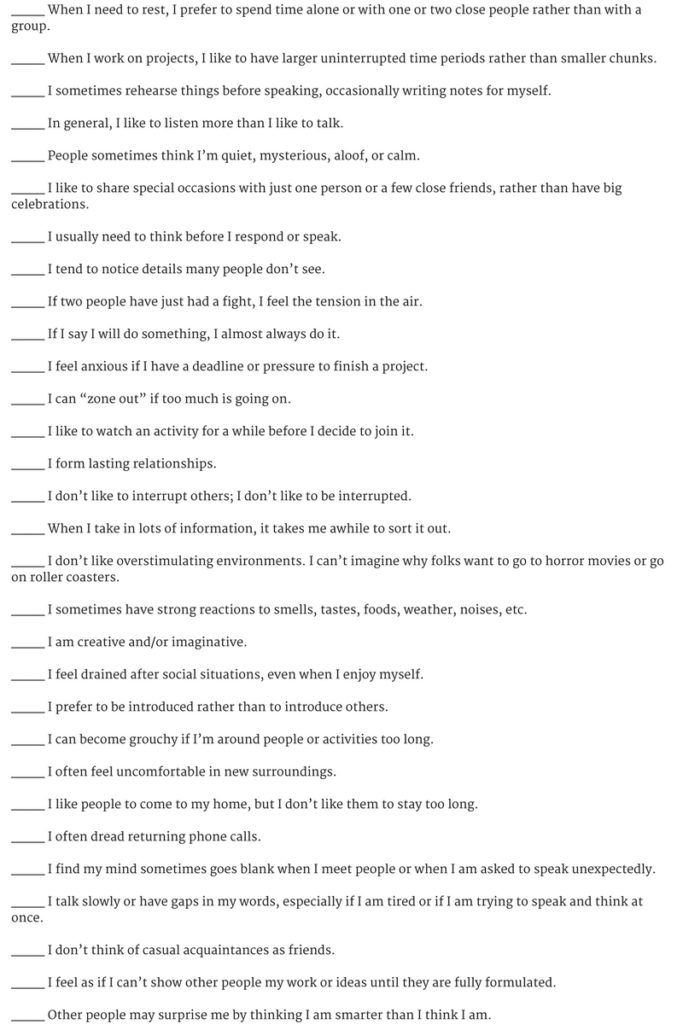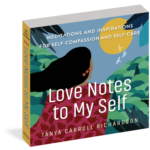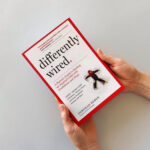Excerpted from Marti Olsen Laney’s The Introvert Advantage.

Self-Assessment for Introverts
Take this test for introversion on a day when you are feeling relaxed and not stressed out. Pick a cozy nook where you won’t be interrupted. Consider each statement in terms of what is generally true or false for you, not how you wish you were or how you are some of the time. Don’t analyze or think too deeply about each statement. Your first impression is usually the best. For an outside view of yourself, it can be enlightening to have a partner or friend answer for you. Compare your results with your friend’s score. If the two tallies differ, talk about both of your views.
Answer the following questions T or F (print it here), then add up your True answers and check the scoring at the end of the list to see if you’re an introvert, fall in the middle of the continuum, or are an extrovert.
Add up the number of Trues. Then read the following to see where you fall.
20–29 True:
Pretty darn introverted. As a result, it is extremely important for you to understand how to keep your energy flowing and how your brain processes information. You relate to life through your ideas, impressions, hopes, and values. You are not at the mercy of your external environment.
10–19 True:
Somewhere in the middle. Like being ambidextrous, you are both introverted and extroverted. You may feel torn between needing to be alone and wanting to be out and about. So it’s very helpful to notice when and how you consistently feel more energized. You judge yourself by your own thoughts and feelings and by the standards of other people. This gives you a broad view, but at times you may get caught up in seeing both sides of a situation and not know where you stand. It is important to learn to assess your temperament so you can maintain your energy and balance.
1–9 True:
You are more extroverted. You judge yourself in the light of the values and reality of others. You work within the bounds of what exists to bring about change. As you reach midlife and your body slows down, you may surprise yourself by wanting to take a break from socializing or needing time to yourself and then not knowing what to do. You can develop techniques to help yourself remember what is best for you to do when you need solitude. To do this you will have to balance your extroverting skills by learning more introverting skills.
If you’re still not sure if you’re an innie or an outie, consider the following question: In a crisis, do you tend to feel shut down and somewhat detached and to respond in slow motion? Or do you tend to move your body immediately, take action without even thinking? During a stressful event, we revert to our basic hard wiring. If you tend to pull back, a hush falling over you like a fog, then you are more introverted. If you are more extroverted, you react by propelling yourself forward into action. There’s value in each reaction.
To learn more about each type, check out the book.
 About the Book:
About the Book:
At least one out of four people prefers to avoid the limelight, tends to listen more than they speak, feels alone in large groups, and requires lots of private time to restore their energy. They’re introverts, and here is the book to help them boost their confidence while learning strategies for successfully living in an extrovert world.
After dispelling common myths about introverts-they’re not necessarily shy, aloof, or antisocial–The Introvert Advantage explains the real issues. Introverts are hardwired from birth to focus inward, so outside stimulation-chitchat, phone calls, parties, office meetings-can easily become “too much.”
The Introvert Advantage dispels introverts’ belief that something is wrong with them and instead helps them recognize their inner strengths-their analytical skills, ability to think outside the box, and strong powers of concentration. It helps readers understand introversion and shows them how to determine where they fall on the introvert/extrovert continuum. It provides tools to improve relationships with partners, kids, colleagues, and friends, offering dozens of tips, including 10 ways to talk less and communicate more, 8 ways to showcase your abilities at work, how to take a child’s temperament temperature, and strategies for socializing. Finally, it shows how to not just survive, but thrive-how to take advantage of the introvert’s special qualities to create a life that’s just right for the introvert temperament, to discover new ways to expand their energy reserves, and even how, when necessary, to confidently become a temporary extrovert.
Buy the Book
Amazon | B&N | Indiebound | Workman






No Comments